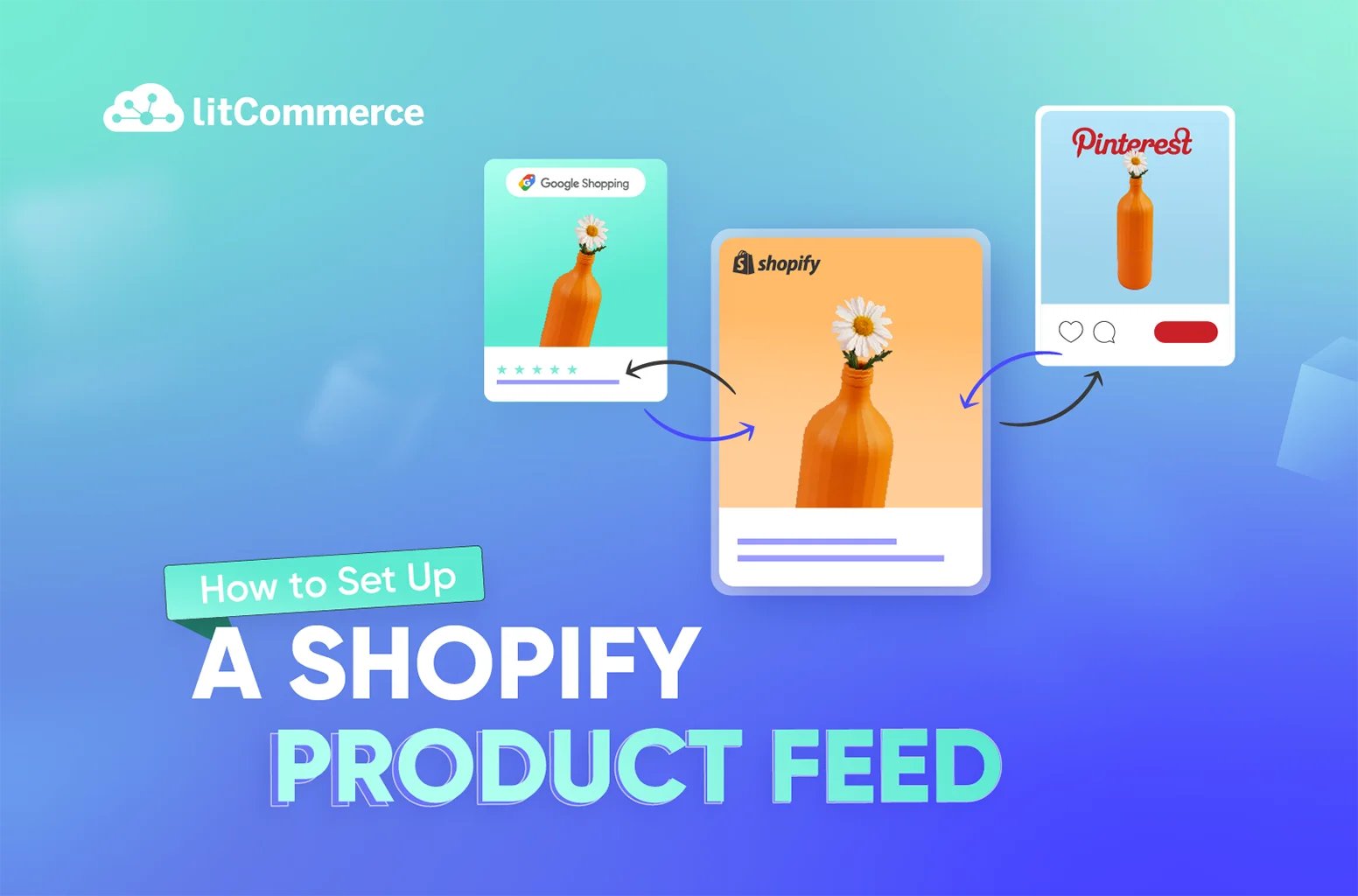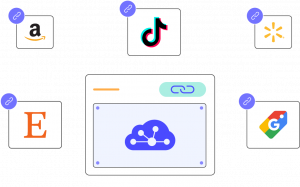Ever wondered why your Shopify products aren’t getting the visibility they deserve? If your listings aren’t optimized for platforms like Google Shopping, Facebook, or TikTok, you’re missing out on massive sales opportunities. That’s where a Shopify product feed comes in—your secret weapon for boosting product visibility and driving more traffic to your store.
A well-structured product feed ensures your products appear in front of the right audience, increasing clicks and conversions. But simply generating a feed isn’t enough—it needs to be optimized, regularly updated, and tailored to different sales channels.
In this guide, we’ll cover:
- What is a Shopify product feed?
- 2 methods to create a product feed on Shopify
- Best practices to optimize your product feed
- Top Shopify product feed apps to automate the process
Ready to maximize your store’s potential? Let’s dive in!
What is a Shopify Product Feed?
A Shopify product feed is basically a structured data file that contains essential details about your Shopify products in one place. It includes your product details like product names, descriptions, prices, stock availability, images, and links. This product data feed can be used to showcase your products on platforms like Google Shopping, Facebook, and more.
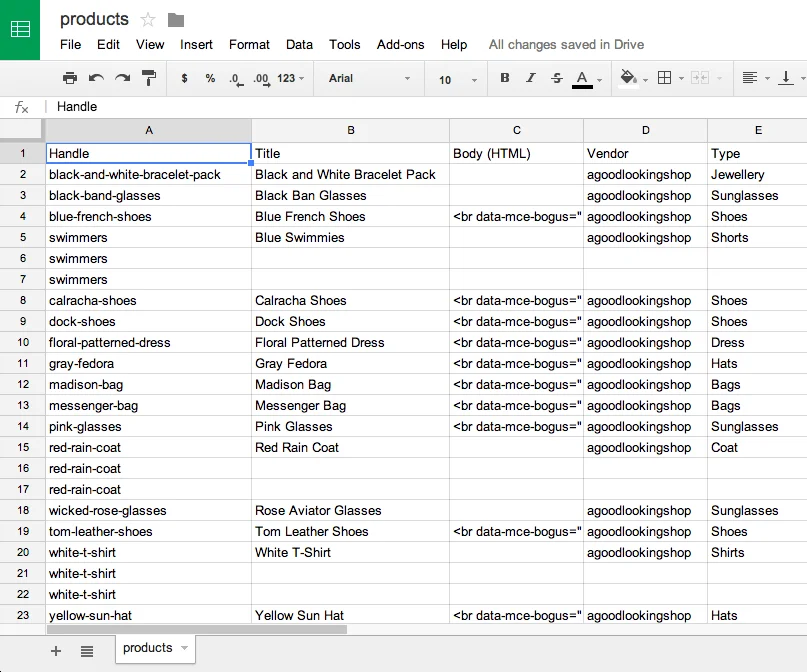
How Shopify product feeds work?
A Shopify product feed exports all your product information in a format that can be readable by external platforms. For example, when you set up a Google Shopping feed, Google pulls data from your product feed URL, ensuring all product details are correctly displayed in Google Shopping ads.
The most common feed formats include:
- CSV (Comma-Separated Values) – A basic spreadsheet format
- XML (Extensible Markup Language) – More structured and widely used for Google Shopping feeds
- TXT (Plain Text) – Occasionally used for ad platforms like Bing Shopping
What is my Shopify product feed URL?
A Shopify product feed URL is a direct link to a structured data file, typically in XML or CSV format, that contains all the key details about your products. Think of it as a connector between your Shopify store and external platforms like Google Shopping, Facebook Ads, and price comparison sites. It automates the process of sharing up-to-date product information, helping you reach more customers without manual updates.
The URL for yourproduct feed varies based on how you generate and manage it.
- If you’re using a third-party app or plugin, the app will provide a unique product feed URL.
- If you’re working with the Shopify API, the feed URL will depend on the specific settings and parameters you’ve configured.
For Shopify API users, the standard format looks like this: https://[store-name].myshopify.com/admin/api/2022-07/products.json
Just replace [store-name] with your actual Shopify store name to access your feed.
In a nutshell, with a properly optimized product feed, you increase product visibility, improve search rankings, and boost conversion rates. So, how to create a Shopify product feed? Let’s move to the step-by-step guide on creating it!
Simplify Multi-Channel Advertising with LitCommerce
Manage and optimize your product listings across multiple platforms from a single dashboard. LitCommerce automates feed updates, categorization, and optimization, saving you time and increasing your products’ visibility.
How to Create a Shopify Product Feed?
Setting up a Shopify product feed is essential if you want to sell on multiple platforms. There are several methods to create a product feed on Shopify, the 2 most popular are:
- Creating a product feed manually on Shopify
- Using Shopify product feed apps
Method 1: Create a Shopify product feed manually
If you prefer full control over your data and have a small inventory, manually creating a product feed on Shopify might be a good option.
Here’s how to create a Shopify export product feed manually:
- Log in to Shopify and access the admin panel.
- Export product data by selecting your products in the ‘Products’ section and downloading them as a CSV file.
- Customize and optimize the product feed file by adding key details like product name, description, price, URL, image URL, and availability to match the requirements of the sales channels you want to link your product to. For example, if you’re targeting Google Shopping, ensure your feed follows Google Merchant Center guidelines.
- Save and host your feed file on a web server or cloud storage, which will act as your Shopify product feed URL.
While this manual method gives you complete control, it might cause errors and missing data, less efficient and time-consuming if you have a large inventory. It doesn’t update in real-time, meaning you’ll need to refresh it manually to keep product details accurate.
If you have a big inventory, you might want to discover the second method: Use Shopify apps to create product feeds.
Method 2: Generate Shopify product feeds using apps
For growing businesses and sellers advertising across multiple channels, using Shopify product feed apps is the best choice for automation, accuracy, and efficiency. These apps pull real-time product data and sync it directly with your sales channels, advertising, or price comparison platforms.
LitCommerce provides a quick and seamless process among various options. In this guide, we will show you how to set up a Shopify product feed with LitCommerce.
Step 1: Connect Shopify to LitCommerce
On the LitCommerce app, connect your Shopify store as your main sales channel. This ensures your product data is synced properly for feed generation.
Step 2: Select a channel to create your feed
Next, choose the sales channel where you want to generate your Shopify product feed.
1️. On the left-side menu bar, click Feed Management > Add/Manage Feeds.
2️. Search for your target sales channel (Google Shopping, Facebook, TikTok, etc.) and select it.
3️. Configure your Shopify feed setting by entering a feed name, selecting the destination country and the market.
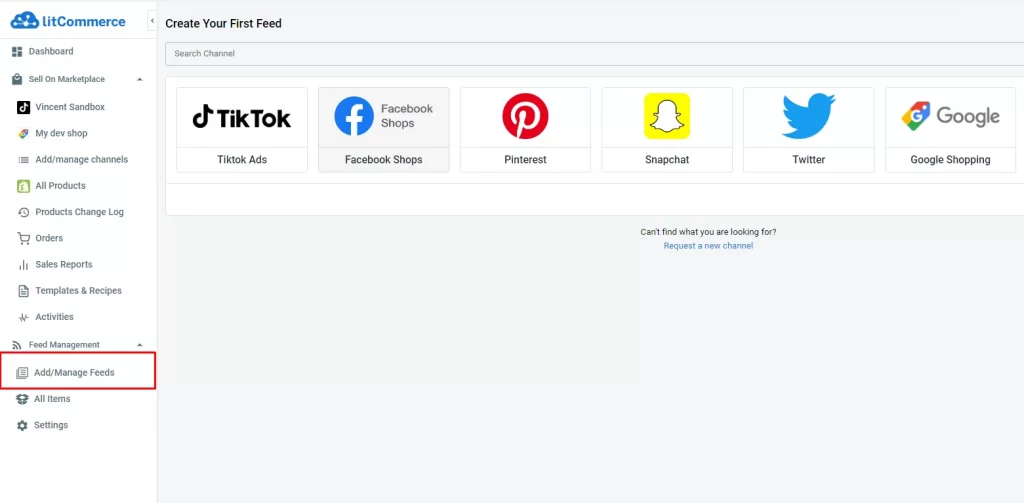
Step 3: Customize and optimize your Shopify product feed
Each platform plays with its own set of rules. So, in this step, use LitCommerce’s customization features to optimize your feed and ensure it meets the specific requirements of your chosen platform.
Here are 4 main features of LitCommerce Feed Management Tool that helps improve your Shopify product visibility and ad performance across different platforms.
- Categorization: Group and assign products to the correct category.
- Rules: Set up automation rules for pricing, inventory, and data modifications.
- Mapping: Align product attributes with the selected sales channel.
- Quality Check: Identify and fix errors before submitting your Shopify product feed.
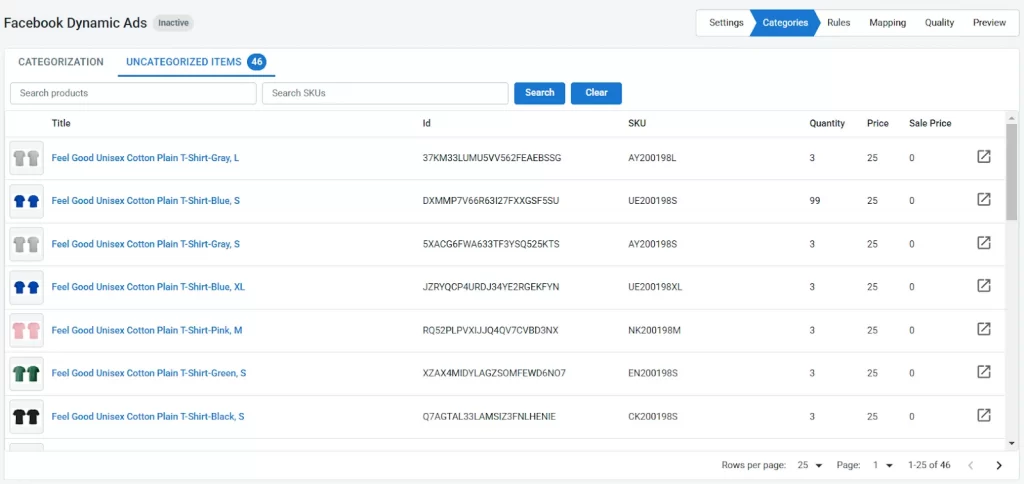
Step 4: Get Your Shopify Product Feed URL
Once you have finished the steps above, the left step is to get your Shopify product feed URL.
1️. Navigate to the Preview section of your feed.
2️. Copy the feed URL displayed at the top of the screen.
When getting your Shopify product feed URL, ensure your feed is active by checking the toggle in Feed Settings. If the toggle is gray with the message “This feed is not activated,” your feed is inactive. Switch it on to activate the feed.
Once activated, your Shopify product feed URL is ready to be used for Google Shopping, Facebook Ads, and other marketing platforms.
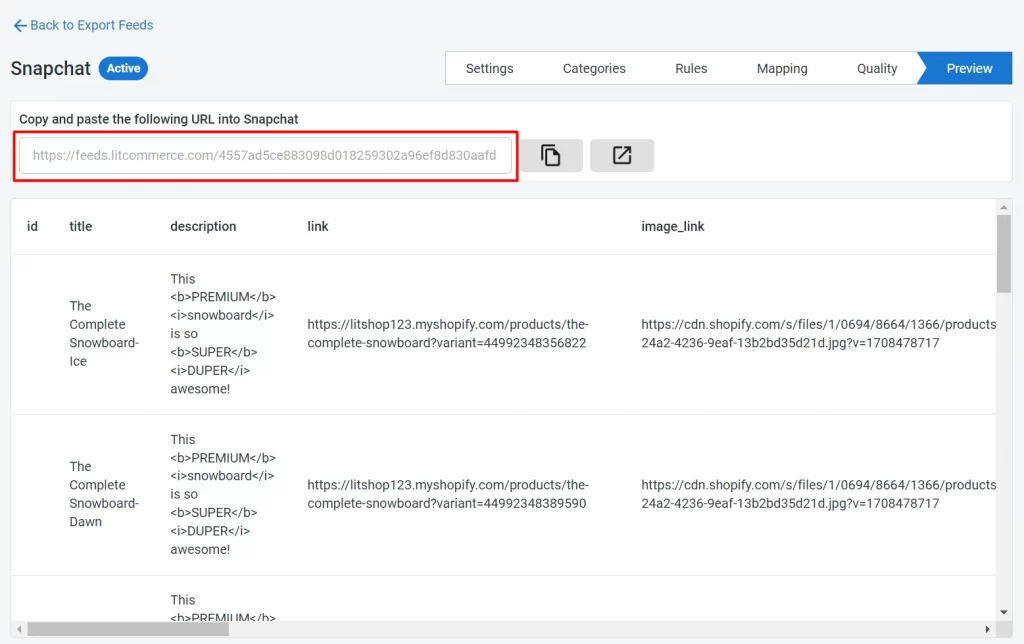
By following these steps, you can automate feed management, reduce manual work, and optimize your listings for better sales performance. Need help? Visit LitCommerce Support for additional guidance!
Now that you’ve set up your product feed, the next step is crucial—optimizing your Shopify product feed for maximum visibility. Let’s dive into Shopify product feed optimization strategies!
LitCommerce – Your Go-To Solution to Automate Your Feed Management
Keep your product data up-to-date effortlessly. LitCommerce offers flexible sync schedules and real-time updates, ensuring your inventory and pricing are always accurate across all channels.
How to Optimize Your Shopify Product Feed for Maximum Visibility
Creating a Shopify product feed is just the first step. To ensure your products get noticed, appear in relevant search results, and attract buyers, you need to optimize your product feed. Poorly optimized feeds can lead to low visibility, incorrect product listings, and wasted ad spending.
In this section, we’ll cover essential best practices to improve yourfeed and maximize your reach across platforms like Google Shopping, Facebook, TikTok, and more.
1. Improve product titles and descriptions
Your product titles and descriptions play a critical role in how your products rank in search results on Google Shopping, Facebook Marketplace, and other sales channels. The goal is to make them clear, keyword-rich, and enticing to shoppers.
A great Shopify product feed title should:
- Include relevant keywords
- Be concise yet descriptive (keep it under 150 characters)
- Highlight key product attributes (brand, size, color, model)
Example:
Instead of: Sneakers for men
Use: Nike Air Max 270 Men’s Running Shoes – Black, Size 10
2. Use high-quality images and variants
Images directly influence buying decisions. In fact, 75% of online shoppers rely on product photos to make a purchase. A poor-quality image can drive potential customers away.
Follow these image guidelines to maximize your Shopify product feed performance:
- Use high-resolution images (at least 1000×1000 pixels)
- Ensure white or transparent backgrounds for a clean look
- Include multiple angles to showcase details
- Use zoom-in features for better product visualization
Additionally, if your product has multiple variations (sizes, colors, styles), make sure they are properly included in the Shopify product feed to give customers more choices.
- Ensure all variants are listed separately with unique SKUs
- Upload variant-specific images to match each selection
- Clearly label size, color, and material options
3. Ensure accurate product data & pricing
A Shopify product feed must always be accurate and up to date. Incorrect pricing, stock availability issues, or missing details can lead to listing disapprovals or poor customer experience. For example, if your Shopify product feed CSV lists an item as “In Stock,” but your store shows “Sold Out,” Google may suspend your listing.
So, how to avoid common errors?
- Use automatic pricing sync tools from Shopify product feed apps.
- Ensure each product has a valid GTIN, MPN, or SKU for better indexing.
- Enable real-time stock updates.
4. Leverage product categories and tags
Did you know? Well-categorized feeds have 30% higher click-through rates than unstructured ones. Proper categorization helps search engines and shopping platforms better understand your products. This ensures that they appear in relevant search results and reach the right audience.
Some of the best practices for product categories & tags are:
- Use Google’s Product Taxonomy for better indexing
- Avoid broad categories – be as specific as possible
- Add descriptive tags like “summer collection,” “organic material,” or “new arrival.”
Now that you know how to optimize your Shopify product feed, the next step is finding the right tools to automate and simplify the process.
Top 7 Best Shopify Product Feed Apps in 2025: Automate & Optimize Your Listings
Managing and optimizing a product feed manually can be overwhelming, especially for businesses having a large inventory and selling on multiple platforms. Shopify product feed apps simplify the process by automating feed creation, updating inventory in real-time, and ensuring compliance with platform-specific requirements.
Below, we’ve compiled the top 7 Shopify product feed apps to help you choose the best one for your store.
1. LitCommerce Product Feeds
LitCommerce Product Feeds is one of the best Shopify apps that makes creating a product feed for multiple platforms easier. This app allows you to sync your Shopify product feed across Google Shopping, Facebook, Pinterest, Adwin, and more, ensuring consistent and accurate listings. Its user-friendly interface makes it ideal for both beginners and advanced sellers.
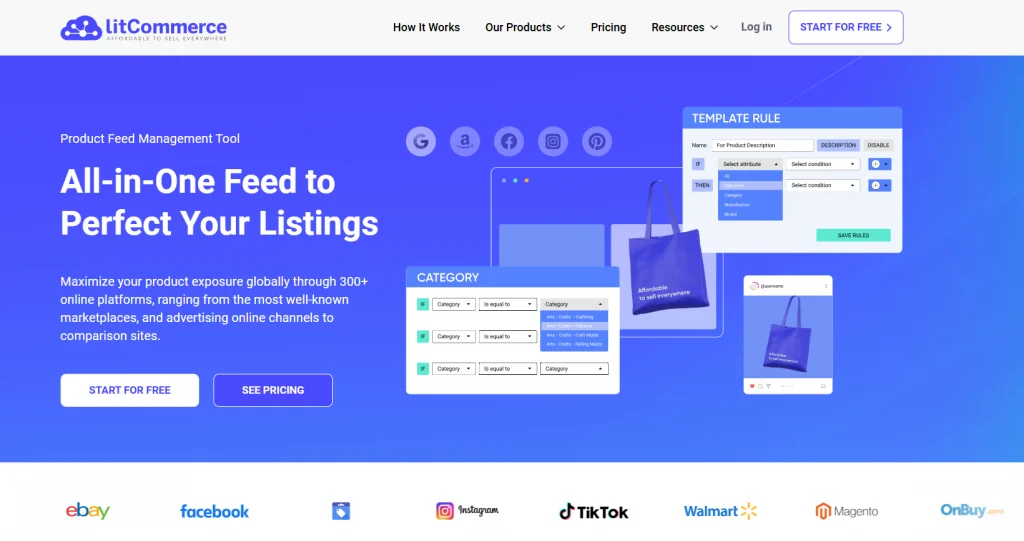
Key Features:
- Supports nearly real-time product feed synchronization across multiple platforms
- Automated inventory updates to prevent mismatches
- Customizable feed templates for different sales channels
Pros:
- Simple interface, ideal for beginners
- Affordable pricing with a free trial
Cons:
- Some advanced features require higher-tier plans
Best for: Merchants selling across multiple platforms who need an easy-to-use, automated feed solution.
2. Simprosys Google Shopping Feed
If your main focus is advertising on Google Shopping and Microsoft Bing, Simprosys Google Shopping Feed is one of the best Shopify product feed apps. It directly integrates with Google Merchant Center and offers advanced feed optimization tools to improve product rankings and conversions.
Key Features:
- Direct integration with Google Merchant Center & Microsoft Bing
- Automated product feed optimization for Google Shopping
- Bulk product editing & advanced filtering options
Pros:
- Google-approved partner app
- Easy integration with Google Performance Max campaigns
- Helps fix feed disapprovals quickly
Cons:
- Limited support for other marketplaces like Amazon or eBay
Best for: Shopify store owners focused on Google Shopping & Bing Ads campaigns.
3. FeedHub: Google Shopping Feed
For merchants looking for automated feed optimization, FeedHub uses AI to structure and enhance product feeds for better search rankings and ad performance. It integrates seamlessly with Google, Facebook, and Instagram, helping you reach a broader audience.
Key Features:
- AI-powered feed optimization for better product ranking
- Supports Shopify export product feed in XML, CSV, and JSON formats
- Automatic keyword insertion to improve SEO
Pros:
- Helps improve ad performance & conversions
- AI-based feed enhancements reduce manual work
- Affordable pricing
Cons:
- Limited features for multi-channel sellers
Best for: Shopify merchants looking to automate & enhance their product feed for better rankings on Google Shopping.
4. Nabu for Google Shopping Feed
If you’re looking for a data-driven approach to optimizing your Shopify product feed, Nabu for Google Shopping Feed is an excellent choice. The app leverages AI-powered strategies to optimize product titles, descriptions, and categories for maximum ad visibility.
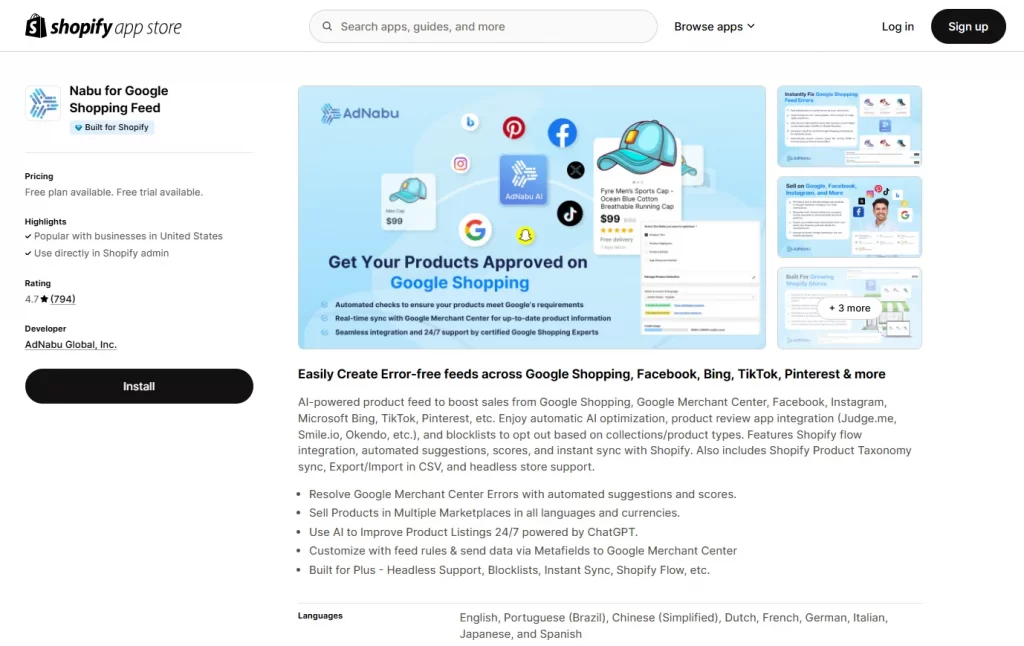
Key Features:
- Uses AI to optimize product feeds for better performance
- Fixes common feed errors to prevent ad disapprovals
- Helps with Google Merchant Center account setup & troubleshooting
Pros:
- Saves time by automating feed error detection & corrections
- AI-based keyword optimization improves CTR
- Supports multiple ad platforms
Cons:
- Higher pricing compared to some competitors
Best for: Shopify store owners who want to use AI-driven strategies to improve ad performance.
5. Multifeed for Google Shopping
Expanding your Shopify products into international markets? Multifeed for Google Shopping is designed for businesses that sell in multiple countries and languages, providing auto-translation and currency conversion to match each region’s marketplace requirements.
Key Features:
- Allows multi-country & multi-language feed support
- Syncs Shopify product feed URLs across different Google Merchant Center accounts
- Automatic currency conversion & language translation
Pros:
- Perfect for global eCommerce businesses
- Helps scale Google Shopping campaigns across multiple regions
- Saves time with auto-currency & language sync
Cons:
- Can be complex for beginners
Best for: Shopify sellers looking to expand their Google Shopping ads internationally.
6. Omega Facebook Pixel & Feed
For businesses focused on social media advertising, Omega Facebook Pixel & Feed is a great Shopify product feed app that offers seamless integration with Facebook and Instagram ads. This app tracks customer interactions, syncs product feeds, and enables dynamic retargeting for better conversions.
Key Features:
- Auto-sync Shopify product feeds with Facebook & Instagram
- Tracks conversions & customer behaviors with Facebook Pixel integration
- Supports dynamic remarketing for better ad performance
Pros:
- Great for Facebook & Instagram advertisers
- Provides in-depth analytics & tracking
- Easy to set up & use
Cons:
- Limited support for Google Shopping & other platforms
Best for: Shopify sellers focusing on Facebook & Instagram ads for social media marketing.
7. FeedNexa Shopping Feed
If you manage a large inventory and need custom feed management, FeedNexa Shopping Feed allows bulk product editing, category mapping, and feed customization to match different marketplace requirements.
Key Features:
- Bulk edit product feeds before exporting to platforms
- Supports Shopify product feed XML format for Google Shopping
- Custom feed rules & filters to optimize product data
Pros:
- Great for sellers with large inventories
- Allows custom feed adjustments for different platforms
- Affordable pricing
Cons:
- Lacks advanced AI-powered optimization
Best for: Merchants who need customizable & scalable product feed management.
In conclusion, choosing the right Shopify product feed app depends on your business needs. But if you need a complete multi channel feed manager, go with LitCommerce.
Shopify Product Feed – FAQs
A Shopify product feed is a structured data file that contains essential product details, including titles, descriptions, prices, images, stock availability, and more. This feed helps Shopify sellers list their products on platforms like Google Shopping, Facebook, TikTok, and Amazon by keeping accurate and up-to-date product information. To get your Shopify product feed URL, you can use one of these two methods: Your Shopify product feed should be updated in real-time to reflect the latest changes in price, stock availability, and product details. If you’re managing feeds manually, update them at least once a day to prevent outdated listings. Otherwise, you can use the Shopify product feed apps like LitCommerce to automate your feed updating.
Get Your Shopify Product Feed & Boost Your Sales Today!
A well-optimized Shopify product feed is essential for expanding your reach, increasing product visibility, and driving more sales on platforms like Google Shopping, Facebook, and TikTok. Without a properly structured feed, your products may not appear in relevant search results, leading to missed opportunities and lower conversions.
To win against your competitors, choose the right Shopify product feed app, optimize your product data, and ensure your feeds are always up to date. With the right strategy, your store can reach more customers, maximize ad performance, and scale successfully. LitCommerce is a great product feed management tool that helps you list your products on the most popular advertising platforms. Let’s contact us to discover LitCommerce Shopify integration. We are your great companion in the near future.

